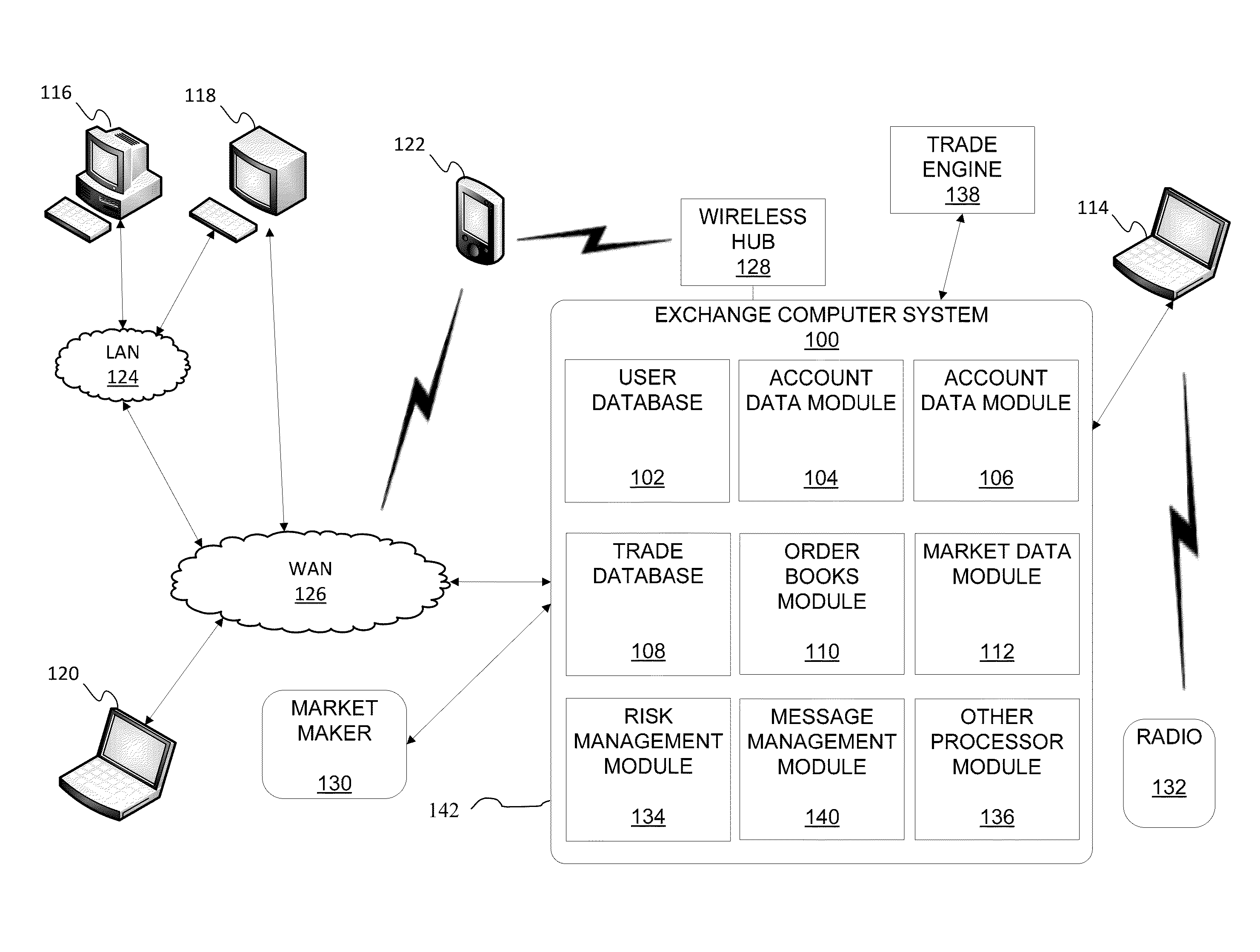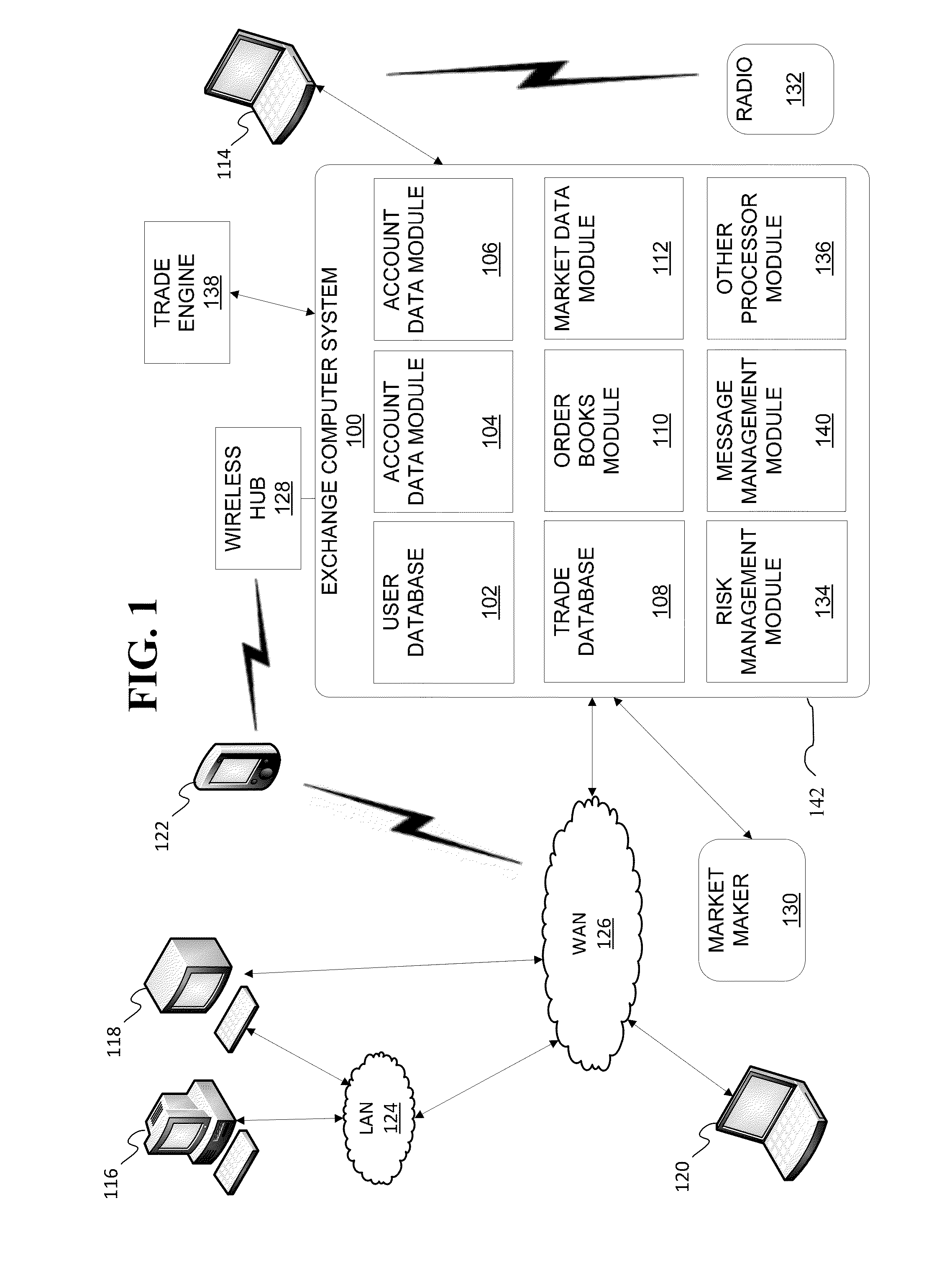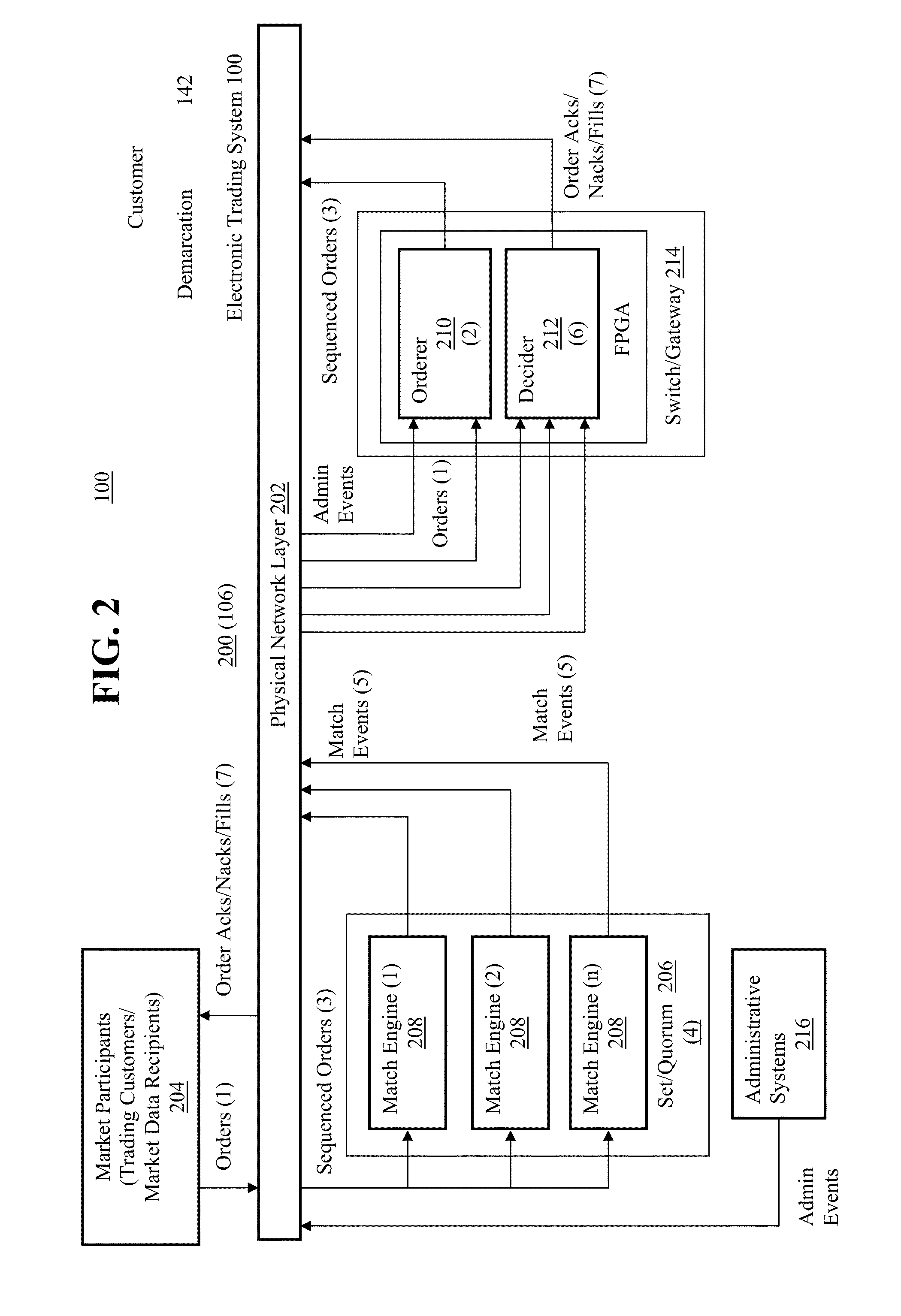Electronic trading systems which implement markets which are overtly or covertly inefficient, unfair or inequitable risk not only losing the trust, along with the patronage, of market participants, but also increased regulatory scrutiny as well as potential criminal and / or civil liability.
Improved speed and efficiency also, unfortunately, improves the speed at which problems may occur and propagate, or otherwise be exploited, such as where the market ceases to operate as intended, i.e. the market no longer reflects a true
consensus of the value of traded products among the market participants.
Such problems are typically, but not always, evidenced by extreme
market activity such as large changes in price, whether up or down, over a short period of time or an extreme volume of trades taking place.
In particular, market participants, whether human or electronic, may not always react in a rational manner, such as when presented with imperfect information, when acting in fraudulent or otherwise unethical manner, and / or due to faulty training or design.
For example, while communications technologies may have improved, inequities still exist in both
access to information and access to opportunities to participate, which may not be due to any violations of legislative, regulatory and / or ethical rules, e.g. some traders receive information before other traders because they can afford faster communications channels, some traders may be able to place trade orders more quickly than others because they have faster computers.
In many cases, irrational and / or exploitive trader behavior may be triggered by a market event, such as a change in price, creating a
feedback loop where the initial irrational reaction may then cause further market events, such as continued price drops, triggering further responses and resulting in an extreme change in the price of the traded product in a short period of time.
High speed trading exacerbates the problem as there may be little time for traders / algorithmic trading systems, or those overseeing them, to contemplate and temper their reactions before significant losses may be incurred.
To improve performance and volume, merely implementing existing systems using newer and faster
general purpose technology may be insufficient.
As such, these optimizations are not necessarily optimized for any one application, e.g. such as for implementing a match engine of an
electronic trading system.
However, such optimizations may, in fact, undermine the application for which the
general purpose processor is being used.
However, as the rate and volume of transactions increases, contention for internal processor resources, such as
memory bandwidth, also increases.
In a multiprocessor environment, this
impact may affect the ability to maintain application tasks / processes, which are divided among multiple processors, in
sync which each other which may result in
out of order execution of one or more transactions.
General purpose processors and operating systems further suffer from their general availability and applicability which has made them susceptible to being reverse engineered and compromised by unknown or uncorrected deficiencies or defects, particularly security related, making them vulnerable to hacking, viruses and other threats.
Accordingly, firewalls or other security appliances, applications or protocols may be required to ensure the safety and security of such systems which further adds latency, degrades
throughput or otherwise impedes performance.
However, merely increasing operating performance, whether via an improved
general purpose processor or via an FPGA based implementation, may
expose, or reduce tolerance of, fundamental flaws of traditional
computer hardware, operating systems or the algorithms / programs implemented thereon, as well as network interconnects /
communications media.
Such flaws, which may result in non-deterministic operation, include manufacturing imperfections / variabilities (
clock skew, long paths, Resistance /
Capacitance (“RC”)
delay, alpha particles, etc.), susceptibility to environmental conditions or changes thereto (temperature,
humidity, solar flares, etc.), and
human error (intermittent or loose connections, improper configuration, etc.).
These flaws may introduce transient errors, such as race conditions, bit errors or
packet loss, which affect deterministic operation.
Furthermore, mere improvements to performance can reveal problems with the applications themselves, such as trading applications or their underlying algorithms.
Further, the occurrence of unaccounted for, or intentionally ignored, assumed-statistically-insignificant events / factors, variables,
rounding errors, corner cases, rare or unexpected / unanticipated states or state transitions may present an
increasing risk.
Generally, speed becomes a lens which creates, or magnifies / reveals underlying, defects and / or divergences, e.g. where a later transaction may overtake an earlier transaction (
race condition), as well as limits
recovery time from, or otherwise reduces tolerance for, errors (transient or systemic (
delay) such as bit errors,
packet loss, etc.).
Such flaws may cause inconsistencies and / or may be unfairly exploited.
However, for many of the reasons described above,
parallel communication paths complicate deterministic behavior, e.g. by creating opportunity, such a via asymmetric delays among communications paths, for later transmitted or arriving transactions to overtake earlier arriving or transmitted transactions, and may require mechanisms to discriminate among closely received transactions and arbitrate among simultaneously, or substantially simultaneously, received transactions, e.g. transactions received at the same time or received within a threshold of time unresolvable by the system.
It will be appreciated that additional conditions may be specified, such as a time or price limit, which may cause the order to be dropped or otherwise canceled and that such an event may result in another non-market-impacting communication instead.
Furthermore, Ticker Plants and trading
software interfaces, which are typically comprised of
custom software, are costly and not all market data recipients can afford to implement them or afford efficient implementations which minimize
delay or provide all of the necessary functionality.
Furthermore, as the disclosed embodiments substantially simultaneously, i.e. with little to no discernable
time difference there tween, transmit both the standard market
data feed and the customized market data feeds, market participants desiring customized data feeds need no longer incur the
disadvantage of the delay imparted by
processing the received data compared with market participants who do not process the market
data feed.
With current
electronic trading system architectures, improving performance may result in reaching or exceeding the capacity of existing infrastructure components, which as was described above, may cause or reveal underlying faults or flaws, such as disparity along communications paths causing
jitter or race conditions which results in non-deterministic operation.
In particular, with respect to
acknowledgement messages sent to specific traders indicative of order
receipt confirmation, match events or other trader specific / privy notifications, and corresponding market
data feed messages sent to all market participants reflecting corresponding market state or changes thereto, these disparities may result in the
acknowledgement message being transmitted to the particular
market participant prior to the corresponding market data message being transmitted to all of the market participants, or vice versa, which may result inequitable / unfair
access to information.
It will be appreciated that market participants may attempt to simulate combination contracts, particularly those not defined by the Exchange and therefore were no specific market for the combination contract exists, by separately submitting the component transactions as separate orders into the associated markets but may incur additional transaction fees and the risk, referred to as “leg risk,” that the individual orders may be not be processed as desired, such as due to a change in the market at the time of submission or
proximate thereto.
However, identifying implied opportunities may be computationally intensive.
Furthermore, identifying implied matches is also computationally intensive.
However, once it is determined that a suitable outright order is not available or there is still residual quantity available in the incoming order, if an implied match is to be found, it must be done so quickly so as not to miss the trading opportunity, e.g. if the implied markets are highly liquid or otherwise volatile, or unduly delay posting the unsatisfied incoming order, or unsatisfied portion thereof, to the order book.
While successful identification of a suitable implied match would benefit the trader by providing a heretofore unavailable opportunity to trade, the delay in performing the identification process may create or increase leg risk or otherwise, especially if unsuccessful, may unduly prejudice that trader.
Identifying an implied match is a complex process because of, among other considerations, the large number of potential order combinations upon which implied orders may be based.
As the number and complexity of the contracts involved in implication gets larger, the number of possible combinations grows exponentially.
For these reasons, trading systems that derive implied orders are often limited by computing capacity and speed.
Conventional trading systems do not have an efficient method of determining all possible or best possible implied markets, especially when the order combinations involve more than a few orders.
This has the practical effect of limiting the degree of liquidity, i.e. opportunities to trade, which the Exchange may offer, thereby limiting the potential revenue, via transaction fees, that the Exchange may earn.
Limited computational capacity / resources of the match engine results in a limited number of order books which can be managed and, therefore, limits the degree of implication.
In contrast, the identification of implied opportunities requires knowledge of the available order books for products sharing at least one common component instrument but review of those order books may be unnecessary assuming an implied match was not previously identified.
For example, due to high volumes, it may be desirable to turn down the frequency of implied opportunity identification, however, turning off implied match identification may change the liquidity
pool and alter the market, so it should remain on during the life of a trading session.
As such transactions may be related to other transactions undertaken by that
market participant as well as other factors, the quantification of the risk of any one transaction may be performed in numerous different ways based on different assumptions, each possibly yielding a different result, and is generally computationally intensive.
When it is determined that a given transaction causes an increase in risk above the defined
credit limit, the transaction may be blocked.
However, limited data storage capacity and / or bandwidth therewith limits the number of order books which may be stored and / or accessed by any given match engine.
They can not trade with other customers, and importantly, they can not make markets themselves.
This gives the trader (customer) control over the price at which the trade is executed; however, the order may never be executed (“filled”).
It will be appreciated that such deterministic processing may, in fact, result in out of
order processing depending on the business rules, such as where conditions for processing orders are imposed which may not be met by an earlier transaction before a later transaction.
It will be appreciated that identifying and defining the boundaries of an inter-networked
communications system, the internal components thereof being interconnected as well, such as between the electronic trading system 100 and market participants and the infrastructure which allows communications there between, may be complex.
Logically, the paths, and the boundaries there between, over which transactions flow and the boundaries between entities may be more difficult to discern.
Thereafter, variation in network path latencies, etc. may impart unequal delays on the delivery of those messages.
In one embodiment, the
market participant may be limited to choosing from among a set of predefined combinations of available customizations, e.g. templates.
In one embodiment, the market participant may be limited to choosing from among a set of predefined combinations of available customizations, e.g. templates.
As was described above, with current electronic trading system architectures, improving performance may result in reaching or exceeding the capacity of existing infrastructure components, which as was described above, may cause or reveal underlying faults or flaws, such as disparity along communications paths causing
jitter or race conditions which results in non-deterministic operation.
In particular, with respect to
acknowledgement messages sent to specific traders indicative of order
receipt confirmation, match events or other trader specific / privy notifications, and corresponding market data feed messages sent to all market participants reflecting corresponding market state or changes thereto, these disparities may result in the acknowledgement message being transmitted to the particular market participant prior to the corresponding market data message being transmitted to all of the market participants, or vice versa, which may result inequitable / unfair access to information.
This ensures that the implied match can be determined and then traded before any of the set of previously received but unsatisfied orders can be matched and traded by other means, undermining the implied match.
This ensures that the implied match can be determined and then traded before any of the set of previously received but unsatisfied orders can be matched and traded by other means, undermining the implied match.
In contrast, the identification of implied opportunities requires knowledge of the available order books for products sharing at least one common component instrument but review of those order books may be unnecessary assuming an implied match was not previously identified.
For example, due to high volumes, it may be desirable to turn down the frequency of implied opportunity identification, however, turning off implied match identification may change the liquidity
pool and alter the market, so it should remain on during the life of a trading session.
As such transactions may be related to other transactions undertaken by that market participant as well as other factors, the quantification of the risk of any one transaction may be performed in numerous different ways based on different assumptions, each possibly yielding a different result, e.g. different accuracy and / or confidence levels, and is generally computationally intensive.
When it is determined that a given transaction causes an increase in risk above the defined
credit limit, the transaction may be blocked.
Additionally, the illustrations are merely representational and may not be drawn to scale.
 Login to View More
Login to View More  Login to View More
Login to View More 


